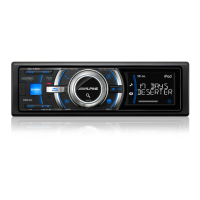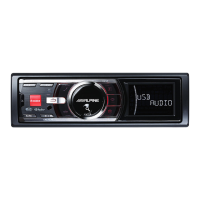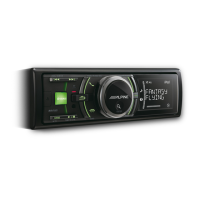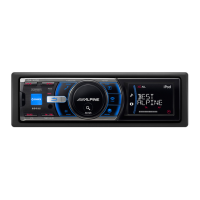
Do you have a question about the Alpine IDA-X303 - Radio / Digital Player and is the answer not in the manual?
| Model | IDA-X303 |
|---|---|
| Brand | Alpine |
| DIN Size | 1 DIN |
| Peak Output | 50W x 4 |
| Number of Channels | 4 |
| Tuner | FM/AM |
| Display Type | LCD |
| Display Illumination | Variable color |
| Bluetooth | No |
| USB Port | Yes |
| USB Input | Yes |
| Aux Input | Yes |
| iPod/iPhone Compatibility | Yes |
| Pandora Control | Yes |
| SiriusXM Ready | Yes |
| HD Radio | No |
| Preamp Voltage | 2V |
| EQ Settings | 3-band parametric EQ |
| Media Type | Digital Player |
| Power Output | 18W RMS |
| Presets | 18 FM, 6 AM |
| Supported Formats | MP3, WMA |
| Preamp Outputs | 3 (Front, Rear, Subwoofer) |
Important instructions regarding warnings, prudence, and precautions for safe operation.
Initial setup, accessory list, and basic operations for the unit.
Setup and operation of the radio tuner, including station memory.
Connecting and operating an iPhone or iPod with the unit.
Adjusting audio parameters like bass, treble, balance, and fader.
Accessing and modifying various system settings and preferences.
Configuring Bluetooth connectivity for hands-free and audio streaming.
Customizing display settings like calendar, clock, and screen modes.
Configuring iPod search modes and related settings.
Settings for HD Radio and Satellite Radio reception.
Details regarding SAT radio reception and related features.
Essential safety instructions to prevent injury or damage.
Precautions for product care, temperature, and maintenance.
Guidelines for proper handling and care of USB storage devices.
Instructions for using and handling portable audio devices.
Describes alternative methods for using the encoder and screen changes.
Lists all included accessories with the unit.
How to connect and disconnect the power supply.
Steps for detaching and reattaching the detachable front panel.
Procedure for initial system setup, including reset.
How to adjust the volume using the encoder.
Basic steps for tuning and operating the radio.
How to manually store favorite radio stations.
Procedure for automatically scanning and storing stations.
How to recall and listen to stored radio stations.
Basic playback functions for iPhone/iPod content.
How to search for specific songs or titles.
Controls for playing music from USB or changer.
Explanation of USB bank function for song organization.
How to use the USB bank feature for easier song management.
How to select discs from an optional CD changer.
Important notes on copyright and usage of audio files.
Explanation of the MP3 audio compression standard.
Explanation of the AAC audio compression standard.
Explanation of the WMA audio compression standard.
Information on software for creating audio files.
List of supported audio file specifications.
Information on ID3 and WMA tag support.
Guidelines for preparing and playing audio files.
Lists the types of media supported by the unit.
Supported file systems for media storage.
Definitions of audio-related terms like bit rate and sampling rate.
Adjusting sound parameters for speakers, loudness, and attenuation.
Enabling or disabling the subwoofer output.
Selecting subwoofer system settings (SYS 1 or SYS 2).
Adjusting the boost or cut level for bass frequencies.
Customizing the width of the bass frequency range.
Setting the center frequency for bass boost.
Adjusting the boost or cut level for treble frequencies.
Setting the center frequency for treble boost.
Settings related to iPod display.
Settings related to tuner display.
Adjusting presets for external audio processors.
Enabling or disabling the Media Xpander feature.
Setting the level for Media Xpander.
Turning the subwoofer ON or OFF.
Configuring the Bluetooth connection for calls and audio.
Changing the calendar display format (M/D/Y, Y/M/D, etc.).
Selecting between 12-hour and 24-hour clock formats.
Setting playback mode for MP3 changers (CD-DA or CD-DA&MP3).
Enabling or disabling audible feedback for button presses.
Controlling automatic audio muting for external device signals.
Enabling AUX+ input for external audio sources.
Customizing the name displayed for the AUX+ source.
Connecting and configuring external audio sources via AUX.
Setting the display name for the optional changer.
Enabling digital audio input for surround sound.
Adjusting the input level for AUX+ sources.
Settings for connecting an external amplifier.
Setting screen brightness automatically or manually.
Choosing how text scrolls on the display.
Setting text scrolling behavior (auto or manual).
Configuring different search modes for iPod content.
Setting display characters for HD Radio station names.
Enabling/disabling digital seek for radio tuning.
How to receive channels from an optional SAT radio receiver.
Overview of Satellite Radio services and features.
Procedure to find the unique identification number for SAT Radio.
How to store team info during a live match broadcast.
Configuring alerts for team matches and scores.
Searching for programs by category.
Switching between MultEQ modes for sound optimization.
Saving custom audio settings to user presets.
Loading previously saved audio settings.
Enabling or disabling the Media Xpander feature.
Applying factory-tuned equalizer settings.
Adjusting sound field parameters like EQ and crossover.
Detailed adjustment of parametric equalizer curves.
Crossover settings for 2.2 channel speaker systems.
Crossover settings for 4.2 channel speaker systems.
Turning the subwoofer ON or OFF.
Selecting subwoofer system settings (SYS 1 or SYS 2).
Setting the subwoofer phase (normal or reverse).
Selecting stereo or monaural output for the subwoofer.
Adjusting the tilt of high-frequency speaker response.
Choosing between graphic and parametric equalizers.
Selecting filter types for speaker outputs.
Introduction to IMPRINT technology for car audio.
Explains the difference between artist's intent and actual car audio.
Discusses acoustic issues within car interiors affecting sound quality.
Highlights the unique features and benefits of IMPRINT technology.
Guidance for diagnosing and resolving common issues.
Troubleshooting no sound from speakers.
Resolving problems with iPod playback and recognition.
Technical specifications for the FM tuner.
Technical specifications for the AM tuner.
Technical specifications for USB connectivity and file support.
General electrical and performance specifications.
Critical warnings regarding installation procedures.
Advice for professional installation and using correct accessories.
General precautions for safe installation and operation.
Notes on ventilation and panel removal during installation.
Steps for removing the detachable front panel.
Wiring for the electric antenna.
Wiring for front, rear, and subwoofer speakers.
Connection point for the antenna cable.
Connecting the electric antenna power control wire.
Connecting the remote turn-on signal for amplifiers.
Input for audio interruption signals.
Connecting the illumination wire for display dimming.
Connecting to the vehicle's ignition power source.
Connecting to the vehicle's battery positive terminal.
Connecting the unit's ground wire to the chassis.
Main power connector for the unit.
Positive terminal for front right speaker connection.
Negative terminal for front right speaker connection.
Positive terminal for rear right speaker connection.
Positive terminal for rear left speaker connection.
Negative terminal for rear left speaker connection.
Negative terminal for front left speaker connection.
Positive terminal for front left speaker connection.
Location for the unit's fuse.
Connection for Ai-NET compatible devices.
Connects to the steering wheel remote control interface.
RCA connectors for rear audio input or output.
RCA connectors for front audio input or output.
RCA connectors for subwoofer audio output.
Ai-NET cable included with CD changers.
Optional RCA cable for extending audio connections.
Connector for the optional Bluetooth interface.
Connection cable for the KCE-400BT Bluetooth interface.
Switch to select between NORM and EXT AP modes.












